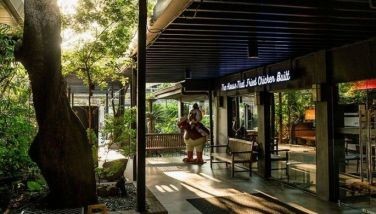Stray reminiscences
March 14, 2005 | 12:00am
Our piece on Carmen Rosales, odd or accidental as it may have appeared (we are a political columnist, remember?) in this space, struck a lodestone of response and reaction. The majority of our readers didn’t even know who she was. They wanted to know more. Carmen Rosales who? Teddy, many of my friends and acquaintances ribbed me, you are showing your age. Well, I never tried to conceal my age. Time and again, I have said in this space, I have logged journalism for more than half a century.
And maybe, this gives me the advantage of space and time over 90 per cent of my colleagues in this media industry. I may know more because I have learned more, and experienced more.
The fact is, the readers were delighted by that piece on Carmen Rosales which could only have been written by a Filipino whose memory goes way, way back. . Indeed, one falls apart as it were in being assailed by the waves of nostalgia. The great Victor Hugo said it best: "When grace is joined with wrinkles, it is adorable. There is an unspeakable dawn in happy old age." Or maybe Goethe said it just as well: "It’s not that age brings childhood back again. Age only shows what children we remain."
Carmen Rosales was just the tip of the iceberg in my mind. My thoughts simply flipped backward, in search of respite from the world of today. Today? One has the feeling of a dwarf – Quasimodo to be sure – carrying a ruthless world on his back, stumbling, rising, stumbling again and rising again, the spittle of labor heavy on his battered jaw. And so we look back to the Philippines of yesteryear, the Manila of yesteryear, and the smiles come back, happy smiles, rueful smiles, gladdening smiles.
Another lady comes to mind, the bountiful Susan Magalona. She easily tops my list of the most beautiful Filipinas I have ever seen. I wonder what she is doing now? She wrote me from America about four years go, enclosing pictures of her family and thanking me profusely for what I had written about her in this space. Age was now pitted on her face (Susan must be about 82 today), but age couldn’t quite conceal her splendid features, the bone formation for example. Even as the streaks of advanced age gathered like dusk, she remained formidable.
She wrote that she was fine, everything was okay. Funny. But I never got to meet her. With the name Magalona, Susan was socially perched far above the crowds and gangs I went around with. I would have loved to meet her then at a party, dance with her, get her to talk, laugh heartily if that was possible, yes feel the beating of a Magalona heart against my breast. When she married a Ledesma (was that Carlos or Oscar?), my heart sank, I figured Susan could not belong to anybody. She was mine, ours, a divine angel atop a chariot and nobody, not even a Ledesma, could touch her.
Susan’s beauty was her blessing as well as her curse.
She was sought after by the richest swains in the land. And lived during a time when parents, particularly the Visayan sugar nobility, would decide who their progeny would marry. The marriage with Ledesma didn’t work out. It couldn’t. Susan was far too dazzling, far more intelligent and urbane. So they said. I have no definite information about her love life, but there were so many break-ups. You sensed that immediately after seeing photos of that first marriage. The man was half a head shorter, didn’t belong to her league at all, looked like a hydrant at the altar awaiting his spouse. Yes, I simply thought at the time only the Prince of Wales deserved our Susan.
It was much later on in life that she finally met the man who would sweep her off her feet, a married man yes, with so many entanglements yes, older yes but suave and debonair, cultured. He was a whiff of genuine aristocracy in his every gesture, a man of the world who moved with flair in the fields of art and music. He was a musical personality himself.
When it came to love, or sex if please, there was a genteel atmosphere that no longer exists today. The men behaved like gentlemen, deep into the many folded layers of relations between the two sexes. Now looking back, it reminds me of what Jean Jacques Rousseau said of his beloved.
He said: "Il vaut mieux effleurer la robe of ma bien-aimee au lieu de coucher avec elle." That was a literary gem right out of the ballpark. For Rousseau, real ecstasy came when at a ball, his body would brush off the dress of his beloved, not when he was unduly exercised, puffing and gasping in bed during an orgasm. Many of us young blades were like that at the time. The lovemaking would come when you were married – plop right there in bed – but it would not be as enjoyable.
A woman had to be pure, a virgin. If she was not and this got around, her chances of a good marriage would plummet. It was because she was a virgin that courting her could be the ultimate adventure. This required charm on the part of the man, charm carried to giddy heights by literary or philosophical intellect, a darting, teasing of the eyes, a maneuver into hand gestures laced with wit and humor, and the biggest challenge ahead.
If the men could not satisfy their licit sexual desires, they did the easiest thing – go to a bawdy house and have a big bang. Or seduce the housemaids. Or masturbate and go to confession afterwards. "Father, I played the banjo" or "Father, I played the guitar" or "Father, I played the trombone." It was ridiculously easy to be bathed with sanctifying grace. The father confessor would simply say, "I understand son. For your penance, pray three Our Fathers and three Hail Mary’s."
In my boyhood, I hardly felt the difference between the rich and the poor. There was no such gap as we have today. I roistered with the "downtrodden" and "kapus palad" in our Pasay neighborhood with effortless ease, played baseball, boxing and volleyball, engaged in fist-fights, easily absorbed their street vocabulary. The poor then didn’t have much of a hang-up in being poor, except the peasantry in Central Luzon.
There was no urban squalor then, no barong-barongs that stuck out like jumbo matchboxes, no sick kids with big bellies, no heaps of garbage. What you heard mostly in the main streets were the clatter of carretelas, the clangor of the trambia, as inspectors mounted and dismounted here and there to check and punch your tickets.
Shopping malls? They didn’t exist. You did your shopping at Escolta and Avenida Rizal and Quiapo. There were food stalls in the markets and food was shockingly inexpensive. Once in a while I would spot some rich people eating in these markets. They told me, almost apologetically, they were tired of the food they were eating at home, and relished eating the food of the poor. They loved the bibingkas, gruel with vegetables, the halo-halo of course, and even mongo, tuyo and tinapa.
I well remember an old friend, still alive, unto the manor born who told me he often ate with the household help, because he liked their simple fare, their pinakbets, and denengdengs, even their daing and puto bong-bong. A mestizo aristocrat, he didn’t find anything wrong eating with them even as he easily sashayed into the gra! nd, festive balls and galas of the rich and the mighty. He had a big name.
You do not find his kind anymore. Pity. Manila was still unspoiled then. The Ermita and Malate districts were peopled by the upper classes that hardly ever flaunted their power and wealth. Politicians in those days were by and large respected and there was no such monstrosity then as the pork barrel. There was a cabinet member, a secretary of health, if I remember, who rode buses or the trambia on his way to work and back.
Ah yes, the gays.
There were no gays then, and if there were, they hid this "infirmity" with unaccustomed skill and ingenuity. To be gay publicly was to court contempt and ridicule, if not physical abuse from even their parents. And beatings. And so they were male in every sense, not the limp-wristed, hip-swaying "swards" they are today, omnipresent in TV sit-coms, even in the boardrooms of TV and radio.
I was present when once Jaime Cardinal Sin, still archbishop of Manila was asked whether he would agree to gay marriage. Stung and outraged by the question, the archbishop could only rear his head in disbelief and exclaimed softly "Jesus, Maria, Joseph!"
An intellectual friend once told me the "effeminazation" of Philippine society today explains the profusion of gays. Our macho world, he said, is beginning to disappear, our adoration of the Blessed Virgin May a religious power symbol that draws men to the world of women. Do I believe that?
Does mariolatry also explain why our male athletes, once the best in Asia during the Far Eastern Athletic Association games (the Asian Olympics then) no longer perform as well, in fact now inhabit the cellar in the Asian Games and have fallen far below par in the Southeast Asian Games? Do I believe that?
Sometimes, it makes sense. Once upon a time, we Filipinos made male athletes in other Asian countries shudder. Our boxers were the best, our basketball players impregnable, our golfers tops, our baseball the envy of Asia with the exception of Japan. Jumping Jehosophat, we have gone far afield in our reminiscences, it seems.
An old journalist never dies. He just lapses into nostalgia.
And maybe, this gives me the advantage of space and time over 90 per cent of my colleagues in this media industry. I may know more because I have learned more, and experienced more.
The fact is, the readers were delighted by that piece on Carmen Rosales which could only have been written by a Filipino whose memory goes way, way back. . Indeed, one falls apart as it were in being assailed by the waves of nostalgia. The great Victor Hugo said it best: "When grace is joined with wrinkles, it is adorable. There is an unspeakable dawn in happy old age." Or maybe Goethe said it just as well: "It’s not that age brings childhood back again. Age only shows what children we remain."
Carmen Rosales was just the tip of the iceberg in my mind. My thoughts simply flipped backward, in search of respite from the world of today. Today? One has the feeling of a dwarf – Quasimodo to be sure – carrying a ruthless world on his back, stumbling, rising, stumbling again and rising again, the spittle of labor heavy on his battered jaw. And so we look back to the Philippines of yesteryear, the Manila of yesteryear, and the smiles come back, happy smiles, rueful smiles, gladdening smiles.
Another lady comes to mind, the bountiful Susan Magalona. She easily tops my list of the most beautiful Filipinas I have ever seen. I wonder what she is doing now? She wrote me from America about four years go, enclosing pictures of her family and thanking me profusely for what I had written about her in this space. Age was now pitted on her face (Susan must be about 82 today), but age couldn’t quite conceal her splendid features, the bone formation for example. Even as the streaks of advanced age gathered like dusk, she remained formidable.
She wrote that she was fine, everything was okay. Funny. But I never got to meet her. With the name Magalona, Susan was socially perched far above the crowds and gangs I went around with. I would have loved to meet her then at a party, dance with her, get her to talk, laugh heartily if that was possible, yes feel the beating of a Magalona heart against my breast. When she married a Ledesma (was that Carlos or Oscar?), my heart sank, I figured Susan could not belong to anybody. She was mine, ours, a divine angel atop a chariot and nobody, not even a Ledesma, could touch her.
Susan’s beauty was her blessing as well as her curse.
She was sought after by the richest swains in the land. And lived during a time when parents, particularly the Visayan sugar nobility, would decide who their progeny would marry. The marriage with Ledesma didn’t work out. It couldn’t. Susan was far too dazzling, far more intelligent and urbane. So they said. I have no definite information about her love life, but there were so many break-ups. You sensed that immediately after seeing photos of that first marriage. The man was half a head shorter, didn’t belong to her league at all, looked like a hydrant at the altar awaiting his spouse. Yes, I simply thought at the time only the Prince of Wales deserved our Susan.
It was much later on in life that she finally met the man who would sweep her off her feet, a married man yes, with so many entanglements yes, older yes but suave and debonair, cultured. He was a whiff of genuine aristocracy in his every gesture, a man of the world who moved with flair in the fields of art and music. He was a musical personality himself.
When it came to love, or sex if please, there was a genteel atmosphere that no longer exists today. The men behaved like gentlemen, deep into the many folded layers of relations between the two sexes. Now looking back, it reminds me of what Jean Jacques Rousseau said of his beloved.
He said: "Il vaut mieux effleurer la robe of ma bien-aimee au lieu de coucher avec elle." That was a literary gem right out of the ballpark. For Rousseau, real ecstasy came when at a ball, his body would brush off the dress of his beloved, not when he was unduly exercised, puffing and gasping in bed during an orgasm. Many of us young blades were like that at the time. The lovemaking would come when you were married – plop right there in bed – but it would not be as enjoyable.
A woman had to be pure, a virgin. If she was not and this got around, her chances of a good marriage would plummet. It was because she was a virgin that courting her could be the ultimate adventure. This required charm on the part of the man, charm carried to giddy heights by literary or philosophical intellect, a darting, teasing of the eyes, a maneuver into hand gestures laced with wit and humor, and the biggest challenge ahead.
If the men could not satisfy their licit sexual desires, they did the easiest thing – go to a bawdy house and have a big bang. Or seduce the housemaids. Or masturbate and go to confession afterwards. "Father, I played the banjo" or "Father, I played the guitar" or "Father, I played the trombone." It was ridiculously easy to be bathed with sanctifying grace. The father confessor would simply say, "I understand son. For your penance, pray three Our Fathers and three Hail Mary’s."
In my boyhood, I hardly felt the difference between the rich and the poor. There was no such gap as we have today. I roistered with the "downtrodden" and "kapus palad" in our Pasay neighborhood with effortless ease, played baseball, boxing and volleyball, engaged in fist-fights, easily absorbed their street vocabulary. The poor then didn’t have much of a hang-up in being poor, except the peasantry in Central Luzon.
There was no urban squalor then, no barong-barongs that stuck out like jumbo matchboxes, no sick kids with big bellies, no heaps of garbage. What you heard mostly in the main streets were the clatter of carretelas, the clangor of the trambia, as inspectors mounted and dismounted here and there to check and punch your tickets.
Shopping malls? They didn’t exist. You did your shopping at Escolta and Avenida Rizal and Quiapo. There were food stalls in the markets and food was shockingly inexpensive. Once in a while I would spot some rich people eating in these markets. They told me, almost apologetically, they were tired of the food they were eating at home, and relished eating the food of the poor. They loved the bibingkas, gruel with vegetables, the halo-halo of course, and even mongo, tuyo and tinapa.
I well remember an old friend, still alive, unto the manor born who told me he often ate with the household help, because he liked their simple fare, their pinakbets, and denengdengs, even their daing and puto bong-bong. A mestizo aristocrat, he didn’t find anything wrong eating with them even as he easily sashayed into the gra! nd, festive balls and galas of the rich and the mighty. He had a big name.
You do not find his kind anymore. Pity. Manila was still unspoiled then. The Ermita and Malate districts were peopled by the upper classes that hardly ever flaunted their power and wealth. Politicians in those days were by and large respected and there was no such monstrosity then as the pork barrel. There was a cabinet member, a secretary of health, if I remember, who rode buses or the trambia on his way to work and back.
Ah yes, the gays.
There were no gays then, and if there were, they hid this "infirmity" with unaccustomed skill and ingenuity. To be gay publicly was to court contempt and ridicule, if not physical abuse from even their parents. And beatings. And so they were male in every sense, not the limp-wristed, hip-swaying "swards" they are today, omnipresent in TV sit-coms, even in the boardrooms of TV and radio.
I was present when once Jaime Cardinal Sin, still archbishop of Manila was asked whether he would agree to gay marriage. Stung and outraged by the question, the archbishop could only rear his head in disbelief and exclaimed softly "Jesus, Maria, Joseph!"
An intellectual friend once told me the "effeminazation" of Philippine society today explains the profusion of gays. Our macho world, he said, is beginning to disappear, our adoration of the Blessed Virgin May a religious power symbol that draws men to the world of women. Do I believe that?
Does mariolatry also explain why our male athletes, once the best in Asia during the Far Eastern Athletic Association games (the Asian Olympics then) no longer perform as well, in fact now inhabit the cellar in the Asian Games and have fallen far below par in the Southeast Asian Games? Do I believe that?
Sometimes, it makes sense. Once upon a time, we Filipinos made male athletes in other Asian countries shudder. Our boxers were the best, our basketball players impregnable, our golfers tops, our baseball the envy of Asia with the exception of Japan. Jumping Jehosophat, we have gone far afield in our reminiscences, it seems.
An old journalist never dies. He just lapses into nostalgia.
BrandSpace Articles
<
>
- Latest
- Trending
Trending
Latest
Trending
Recommended























